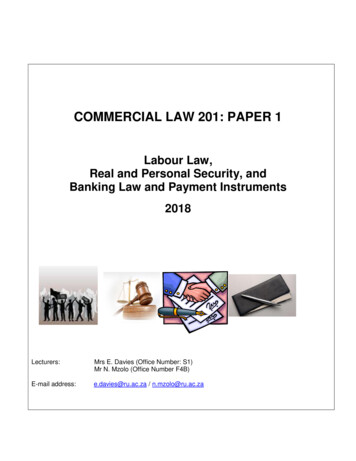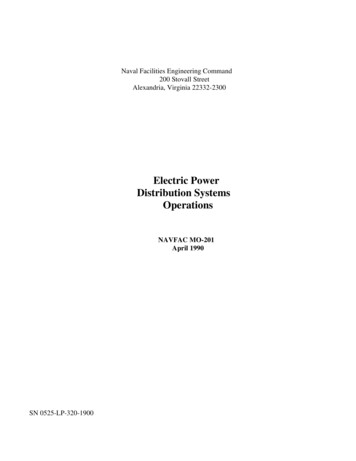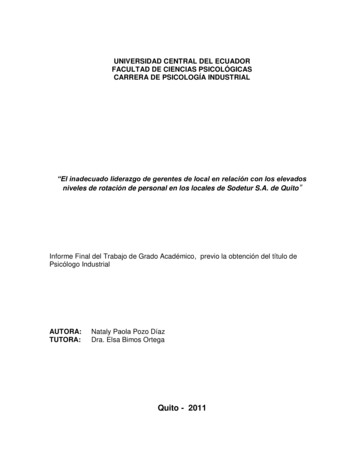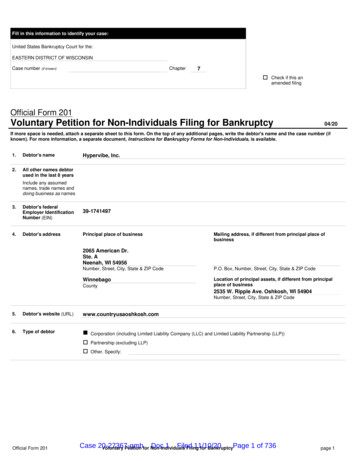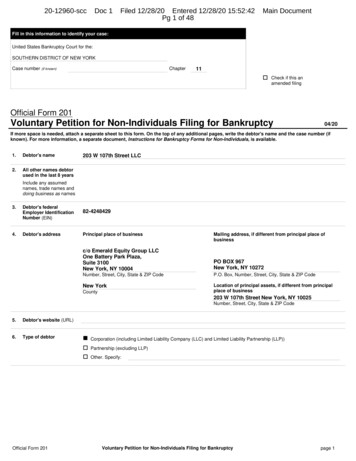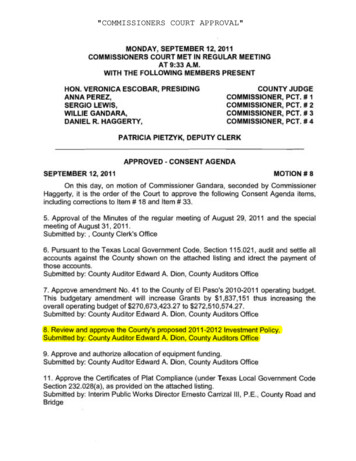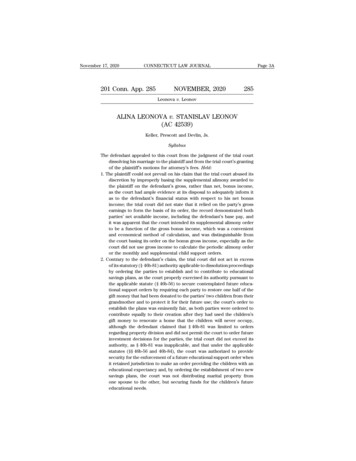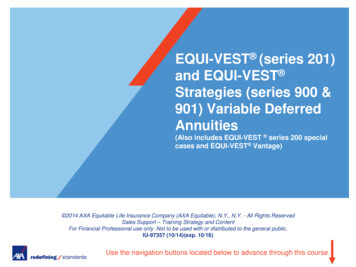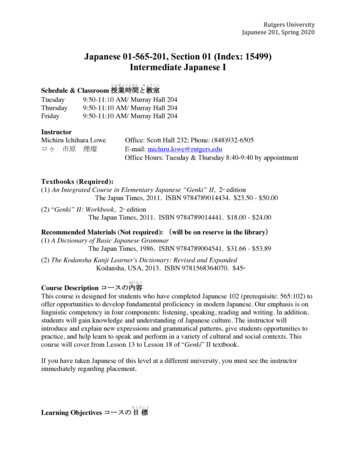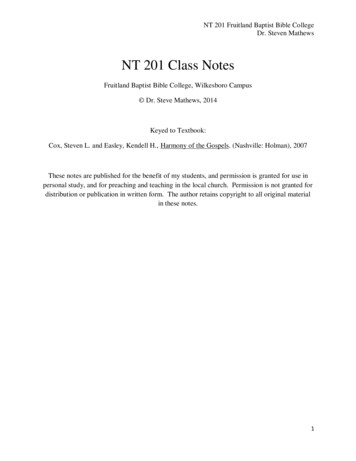
Transcription
NT 201 Fruitland Baptist Bible CollegeDr. Steven MathewsNT 201 Class NotesFruitland Baptist Bible College, Wilkesboro Campus Dr. Steve Mathews, 2014Keyed to Textbook:Cox, Steven L. and Easley, Kendell H., Harmony of the Gospels. (Nashville: Holman), 2007These notes are published for the benefit of my students, and permission is granted for use inpersonal study, and for preaching and teaching in the local church. Permission is not granted fordistribution or publication in written form. The author retains copyright to all original materialin these notes.1
NT 201 Fruitland Baptist Bible CollegeDr. Steven MathewsLESSON 1 (p. 23-38)1I.Sources of the Gospels- Luke 1:1-4a. Luke 1:1-4- Luke identifies the method of his research: an investigation ofeyewitness accounts of the life of Christb. Merrill Tenney1 identifies sources of information for the modern student of thegospels, which provide insight into the history, culture, and politics of the worldof the Gospels:a. Josephus- the most reliable Jewish historian, though he is decidedly biasedtoward the Jews in all his writings.b. Greek historians- Strabo (a source for Josephus), Plutarch, Polybiusc. Roman historians- Cicero, Livy, Suetoniusd. Jewish sources- I and II Maccabees, written in the intertestamental periode. Dead Sea scrolls- OT texts and legal and cultural documentsf. New Testament textg. Apostolic fathers- Those who had contact with the apostles: Irenaeus,Tertullian, Clement of Alexandriah. Apologists- disciples of the fathers, who defended Christianity: JustinMartyri. Church Historians- Eusebius (260-340) wrote an early history of thechurchj. Apocrypha and Pseudopigrapha- non-biblical writings which provide aninsight into some true and false doctrines of the early church.II.The Incarnation- John 1:1-18a. Jesus as the logos- Jesus is the “Word”, the self-revelation of God. “In thebeginning” hearkens back to Gn. 1:1, where God speaks creation into existence.John clearly asserts the divinity of Jesus Christ and His eternal godhead.b. Light and darkness- a common theme in John. The darkness of the world did notunderstand the light of Christ. In John 1, Jesus is the “light”.c. The Word became flesh- this is the incarnation of Jesus. He was fully God andfully man. He demonstrated the glory of the Father.d. The theological term for Jesus being both God and man is hypostatic union. Fromthe Greek hypostasis, meaning “nature”, it means Jesus has two natures, divineand human, in one person.e. Grace and Truth- The truth Jesus demonstrates is that all have sinned and earnedthe just judgment of God; grace is taking this judgment upon Himself.Tenney, Merrill, New Testament Times (Grand Rapids: Eerdmans), 1965, pp. 8-23.2
NT 201 Fruitland Baptist Bible CollegeDr. Steven Mathewsf. Symbols for Jesus in John 1: Word, Light. The purpose of these symbols is thesame (vs. 18)- to reveal God. Just as words reveal thoughts, and light revealsphysical things hidden by darkness, Jesus reveals God to the world.III.Genealogies of Jesus Christ- Mt. 1:1-17; Lk. 3:23b-38a. Matthew and Luke present different genealogies of Jesus. Matthew goes back toAbraham, and Luke goes back to Adam. This may be due to the uniquely Jewishperspective of Matthew, and the Gentile perspective of Luke.b. Some have speculated that Matthew presents here the line of Joseph, establishingthe legal identity of Jesus, while Luke presents the line of Mary. Because they areboth of the tribe of Judah, in the line of David, there is significant overlap.c. Luke’s reference to Jesus being “thought to be the son of Joseph” (Lk. 3:23b) mayprovide the clue that this is Mary’s genealogy.d. Matthew discusses three women in his list: Tamar, Rahab, Ruth, Bathsheeba (notby name, simply as “Uriah’s wife”), and Mary. The first four women wereinvolved in real or apparent sex scandals, and yet were in the line of the Messiah.Mary’s virgin conception and birth would place her into a sex scandal as well.IV.The Birth and Childhood of Jesus and John- Luke 1:5-25, 26-38a. Jesus and John were cousins, and both were born under miraculouscircumstances.b. Both births were impossible or improbable. Mary was a virgin, Elizabeth wasvery old.c. Both births were announced by the angel Gabriel to the human father. The firstwords of the angel were “do not be afraid”.d. Both angelic announcements were questioned (Zechariah in 1:18; Mary in 1:34).Zechariah was rebuked for questioning the angel, and struck dumb, but Mary wassimply encouraged to look to Elizabeth as an example of God’s power.e. Both births were accompanied by a proclamation of the mother as being “favoredby God” (Lk 1:25, 1:30).V.Mary’s Visit to Elizabeth- Lk 1:39-45a. Mary went to see her country cousin, Elizabeth. The visit was probably inresponse to Gabriel’s message, and to get out of town for a while.b. Elizabeth and the pre-born John confirmed Mary’s divine conception and Jesus’deity.c. Mary stayed with Elizabeth for about three months. John is about six monthsolder than Jesus, so it is possible that Mary stayed and helped to deliver John. (vs.56)3
NT 201 Fruitland Baptist Bible CollegeDr. Steven MathewsVI.Mary’s Praise- Lk 1:46-56a. Mary composes a hymn of praise, affirming the following:b. She will be blessed (vs. 48-49)c. God is merciful and mighty (vs. 49-52)d. God is fulfilling His promise to Israel (vs. 54-55)VII.The Birth and Naming of John- Lk 1:57-80a. John’s birth was accompanied by rejoicing.b. Zechariah had been mute since Gabriel’s revelation, but here his mouth wasopened.c. Zechariah’s hymn of praise is know as the benedictus, after the first word in theLatin text.d. In vs. 73, Zechariah links the birth of John to God’s covenant with Abraham.VIII. The Nativity of the Messiah- Mt 1:18-25, Lk 2:1-7a. Marriage consisted of three stages:i. Arrangement- by the families, usually an economic as well as socialarrangement.ii. The formal engagement or betrothal. Usually the man in his 20’s, and thewoman in her early teens, enter a period of public, formal engagement.Marriage at this point has legal status, but sexual relations are forbidden.iii. The consummation- a feast of up to seven days, after which marriage isconsidered final.b. Matthew’s account takes pains to verify that Joseph is a righteous man, and thatMary is a virgin, and that the birth of Jesus is the fulfillment of prophecy (Isaiah7:14).c. During Mary’s pregnancy, the formal wedding occurred, but Joseph did notconsummate the marriage until after the birth of Jesus.d. The accounts of Matthew and Luke invalidate the Roman Catholic doctrine of theperpetual virginity of Mary- Joseph did not know her intimately until after thebirth of Jesus, and Jesus was her firstborn (implying the birth of others).IX.The Shepherds and the Angels- Lk 2:8-20a. The shepherds were in the fields at night. This invalidates December 25 th as thebirthdate of Jesus, as shepherds would not have been in the fields in the winter.This would have been springtime.b. As with the previous angelic visitations, the first admonition of the angels is tonot be afraid.c. Shepherds would have been among the lowest social classes, and may well havebeen children.4
NT 201 Fruitland Baptist Bible CollegeDr. Steven Mathewsd. The shepherds were the first human heralds of the birth of Jesus, the firstevangelists.e. Mary is depicted as “treasuring” these things in her heart. Luke probably spokewith Mary in the preparation of his gospel, so this may be a personal observation.X.The Circumcision and Presentation of Jesus- Lk 2:21-38a. Jesus was presented at the temple at eight days old, as required by the law.b. Bethlehem is about 5.5 miles from Jerusalem, so the timing and geographycorrespond.c. Joseph and Mary offer two doves or pigeons- the offering prescribed for the poor.d. Two people meet Jesus at the temple and validate His divinity.e. Simeon is “righteous and devout”, Spirit-filled, and has eschatological hopes.f. Anna is also depicted as righteous, fasting and praying for the “redemption ofJerusalem”, which mirrors Simeon’s eschatological emphasis.XI.Wise Men Seek the King- Mt. 2: 1-12a. The wise men did not come on the night of Jesus’ birth, as depicted in nativityscenes.b. Jesus is described as a “young child” in a house (vs. 11), rather than a baby in amanger.c. Based on Herod’s massacre of the innocents and the information from the wisemen, Jesus was probably about two years old.XII.The Massacre of the Innocents- Mt. 2:13-18a. Another angelic warning- Joseph is to take Mary and Jesus and flee to Egypt.b. Matthew asserts that this fulfills two prophecies: the Messiah coming up out ofEgypt (Hs 11:1), and His birth being accompanied by the weeping of Jewishmothers (Jr. 31:15).c. Parallels between Jesus’s birth and the experience of Moses in Egypt:i. Jewish baby boys being murdered- all boys under two years old were to bekilled.ii. Crossing from Egypt to Israel through the Sinai.iii. Just as the Passover delivered Israel from Egypt, Jesus delivered the worldfrom sin.iv. Just as Israel wandered for 40 years in the wilderness, Jesus was tempted40 days in the desert (Mt 4).XIII. Jesus in Nazareth- Mt. 2:19-23; Lk 2:40a. An angel told Joseph to return to Israel. In spite of this angelic revelation, Josephalso used his own judgment to decide where to live.b. Judea was a more urban region, and Galilee was rural.5
NT 201 Fruitland Baptist Bible CollegeDr. Steven Mathewsc. Matthew asserts that Jesus’ living in Nazareth is the fulfillment of prophecy, butthere is no corresponding OT text.d. Jesus developed physically (strong), mentally (filled with wisdom), and spiritually(God’s grace was on Him).XIV. The Child Jesus in the Temple- Lk 2:41-50a. Jesus was raised as an observant Jew.b. Extended families would travel together, and 12 year olds were almost consideredadults, so it is not out of the ordinary for parents to allow children some spacewithin the caravan.c. Two parties are depicted as astonished- the teachers and those who heard Jesus’squestions and answers; and his parents.d. Jesus identifies the temple as His father’s house.e. This is the last time we see Joseph alive. It is not known when or how he died,but he was off the scene by the time Jesus began His public ministry at age 30.XV.Eighteen Years in Nazareth- Lk 2:51-52a. Jesus submitted to His parents’ authority.b. Again, Luke depicts Mary as “keeping these things in her heart”.c. More personal growth is depicted in Jesus’ life- wisdom, physical stature,spiritual and social standing.6
NT 201 Fruitland Baptist Bible CollegeDr. Steven MathewsLESSON 2 (p.39-53)I.The Beginning of the Gospel- Mk 1:1, Lk 3:1-2a. The “gospel” is a reference to the message of and about Jesus, rather than thegenre of these books. Mk 1:1 is the source of the name of this genre. He uses theterm also in 1:14-15 and 8:35.b. Luke sets the gospel into its historical context in both Roman legal and Jewishreligious settings.II.John the Baptist- Mt 3:1-6; Mk 1:2-6; Lk 3:3-6a. John is identified with Isaiah by all three synoptic gospels.b. John was outwardly identified by his diet and dress. He wore rough clothing, andforaged for food in the wild. He dressed like Elijah (2 Kg 1:8).c. “Locusts” are not insects, but the pods of the carob tree.d. John was identified by his baptism for repentance. Baptism as ritual washing wasnot uncommon in Judaism. In fact, the Pharisees practiced a ritual immersionwhich represented cleansing.III.John’s Message- Mt 3:7-10; Lk 3:7-14a. Matthew and Luke record essentially the same message: being Jewish does notbring the favor of God, so repentance is required.b. Matthew records John directing these comments at the Pharisees and Sadduceeds,while Luke records them directed at the crowds.c. Matthew does not record the response of the audience (“What then should wedo?”, but Luke does.d. Luke records three groups of people asking John what they should do in responseto his message. The crowds should share their food and clothing; tax collectorsshould not extort people; and soldiers should earn their living honestly.e. These three groups include Jews who are presumed to be faithful to Israel (thecrowds), Jews who are working for Rome (tax collectors), and Romans.f. The message is that repentance should result in a changed life.IV.John’s Anticipation of Jesus- Mt 3:11-12; Mk 1:7-8; Lk 3:15-18a. John ascribes honor to the Messiah- he is unworthy compared with the Messiah.b. All three synoptics mention the baptism of the Holy Spirit, but only Matthew andLuke mention the judgment the Messiah will bring.c. Both Matthew and Luke describe a judgment, a separation of the wheat from thechaff, and a burning of the chaff.7
NT 201 Fruitland Baptist Bible CollegeDr. Steven Mathewsd. After wheat was ground, people would throw it into the air with a pitchfork. Theheavy wheat would fall back to the ground, but the ground husk (the chaff) wouldblow away.e. Luke describes the fiery judgment, and calls it “good news.”V.The Beginning of Christ’s Public Ministry- Jesus’ Baptism- Mt 3:13-17; Mk 1:911; Lk 3:21-23aa. This is the first appearance of the Trinity in the New Testament. The Son is beingbaptized, the Spirit is descending like a dove, and the Father is speaking.b. Jesus said that His baptism was to “fulfill all righteousness”. Jesus did severalthings to establish His human credibility and authority, including His baptism,temptation, payment of temple taxes, etc.VI.The Temptation of Jesus- Mt 4:1-11; Mk 1:12-13; Lk 4:1-13a. Jesus’ temptation in the wilderness parallels Moses’ and Elijah’s 40 day trials inthe wilderness, as well as the Israelites’ 40 years wandering in the wilderness.b. Jesus’ temptation establishes His status as a Hebrew Holy Man. It was his rite ofinitiation into the line of the law and prophets.c. Jesus was tempted in three ways: the lust of the flesh, the lust of the eyes, and thepride of life. This parallels eve’s temptation in the garden of Eden, and I John2:16.d. Jesus’ fasting helped to prepare Him against these temptations.e. Jesus’ fasting was voluntary- if He had the power to raise the dead and heal thesick, then surely He had the power to fast for 40 days and not be hungry. Hevoluntarily felt weakness and hunger in order to identify with human weakness.VII.The Testimony of John the Baptist- Jn 1:19-34a. John’s testimony is in reference to questions about himself.b. John testifies that he is not the Messiah, nor Elijah, nor “the Prophet”, but heforerunner to the Messiah.c. John says that his authority to baptize comes from his identity as the forerunner tothe Messiah.d. John testifies that Jesus is the Lamb of God, and that he has seen the Father andthe Spirit validate His ministry.VIII. Jesus’ First Disciples- Jn 1:35-51a. Jesus’ first two disciples were disciples of John the Baptist. One was Andrew, thebrother of Simon Peter.b. Andrew brought Peter to Jesus.c. Jesus validates himself to Nathanael through His prophetic vision.8
NT 201 Fruitland Baptist Bible CollegeDr. Steven MathewsIX.Jesus’ First Miracle: Water to Wine at Cana- Jn 2:1-11a. Jesus’ miracle may have been to honor His mother Mary, who was pregnant at herwedding, and may not have had the kind of feasting and celebration that usuallyaccompanies a wedding.b. His first miracle demonstrates His power over nature.c. Today, Cana is the “Gatlinburg” or “Las Vegas” of Israel. There are numerouswedding chapels, where Jews and Christians go to be married.X.Jesus Returns to Capernaum- Jn 2:12a. Capernaum was Jesus’ “home base”, and He often returned here.b. He went with His mother, brothers, and disciples.XI.Jesus’ First Cleansing of the Temple- Jn 2:13-22a. The synoptics record a later Temple cleansing, after the triumphal entry.b. This is the first major conflict between Jesus and the Pharisees in John.c. Jesus’s charge is that business has replaced worship.d. Jesus’ disciples ascribe messianic meaning to these events- zeal for God’s houseconsumed the Messiah.e. The Pharisees demanded that Jesus demonstrate his authority to do these things.He offered them a prophecy of His resurrection, which was not understood by thePharisees or His disciples.XII.You Must Be Born Again: Jesus and Nicodemus- Jn 2:23-3:21a. Nicodemus was a Pharisee, and a member of the Sanhedrin, with which Jesus hadhad a recent conflict, but his visit is not confrontational in nature.b. Nicodemus’ visit occurred privately, in the evening, which demonstrates that hispurpose is not to challenge Jesus or to dishonor him, but to ask sincere questions.c. Jesus teaches Nicodemus that the gospel is not about obedience to the law, butabout regeneration- new birth.d. Being born of water (vs. 5) is a reference to natural birth, not to baptism. Itparallels being “born of the flesh” in vs. 6.e. The theme of light and darkness returns here. Jesus asserts that He is the light,and that the world loves darkness more than light.f. When John refers to “the world” (16, 17, 19), it is a reference to the human order,to “the way things are”, rather than a comprehensive statement of all humanbeings. It is also used this way in John 15, when Jesus says that we are not of theworld, but were called out of the world.XIII. Jesus and John the Baptist- Jn 3:22-369
NT 201 Fruitland Baptist Bible CollegeDr. Steven Mathewsa. John the Baptist testifies that he is not a rival of Jesus, and predicts the decreaseof his ministry, and the increase of Jesus’ ministry.b. John the apostle testifies that God has recognized and validated Jesus’ ministry.XIV. Jesus Leaves Judea - Jn 4:1-4; Lk 3:19-20, 4:14a; Mt 4:12; Mk 1:14a. Jesus traveled north from Judea, through Samaria, to Galileeb. Why did Jesus leave the region of Judea?c. John was imprisoned, Jesus’ popularity was growing, and conflict with thePharisees was imminent. It was not yet His time.XV.The Woman at the Well- Jn 4:5-42a. Source of Samaritan/Jewish conflict: goes back to the rebuilding of the templeunder Nehemiah and Ezra- Jews received special favors from the Persiangovernment. Judean Jews did not intermarry, Samaritan Jews did. Samaritansdid not accept the word of the Jewish prophets. During the Maccabean revolt,Jewish nationalists made several guerilla attacks against Samaritan targets,including the temple on the mountain, because the Samaritans supported theGreeks.b. Jesus guides the conversation to Himself as the solution to each of her objections.XVI. Jesus Returns to Galilee- Jn 4:43-45a. Jesus is welcomed in Galilee because Galilean travelers saw His cleansing of thetemple in Jerusalem.b. Their welcome is not a testimony that they believed He was the Messiah, but thatthey agreed with his stand against the religious and political corruption of thetemple.10
NT 201 Fruitland Baptist Bible CollegeDr. Steven MathewsLESSON 3 (p. 54-74)I.Summary of Jesus’ teaching in Galilee- Mt 4:17; Mk 1:14-15; Lk 4:14-15a. Jesus’ message is to repent because God’s kingdom is at hand.b. Jesus taught in the synagogues, and was renowned for His teaching.II.Jesus’ Second Sign- Healing a Nobleman’s Son- Jn 4:46-54a. Jesus heals an absent boy from a distance.b. The father is a royal official.c. This is the first biblical reference to “household salvation”- entire householdscoming to faith in Christ.III.Rejection of Jesus at Nazareth- Lk 4:16-31a. Jesus was rejected for His message, not for his character (vs. 22)b. Jesus said that His rejection is to be expected, citing Elijah and Elisha.c. Jesus’ repudiation of their rejection enraged them to the point of blood lust.d. Jesus passed right through the crowd- it’s not clear if this was a miraculous event,or was based on Jesus’ forceful personality.IV.Jesus moves to Capernaum- Mt 4:13-16a. Jesus made Capernaum His home base.b. Matthew links this move to Isaiah’s prediction in 9:1-2V.Jesus Calls Four Fishermen as Disciples- Mt 4:18-22; Mk 1:16-20; Lk 5:1-11a. Jesus calls Peter, Andrew, James, and John from their nets to follow Him.b. Peter, James, and John form Jesus’ inner circle. They kn
NT 201 Fruitland Baptist Bible College Dr. Steven Mathews 6 c. Matthew asserts that Jesus’ living in Nazareth is the fulfillment of prophecy, but there is no corresponding OT text. d. Jesus developed physically


